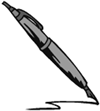| Here's a tip that's fairly self-evident. The better written and more effective your listing title and description, the more successful your auction will be. It's just like advertising copy: Great copy produces the best results. "Mike Sez"  | If you think you're going to get a lot of traffic to your item listing page, by all means display a counter. (It's free, after all.) If, on the other hand, you don't want to tip your hand as to how many potential bidders you might have, go with the hidden counter. |
Write a Title That SELLS! Let's start right at the top, with the title of your item listing. You can use up to 45 letters , numbers , characters , and spaces, and you need to accomplish two things: -
You have to include the appropriate information so that anyone searching for a similar item will find your item in his search results. -
You have to make your title stand out from all the other titles on those long listing pages. tip  | If you're unsure how best to word the title for your item listing, research a few auctions for similar items and " borrow " their wording. |
Let's tackle the first point first. You have to think like the people who will be looking for your item. Most users will be using eBay's search feature to look for specific items, so you want to put the right keywords into your item title to make your item pop up on as many search results pages as possible. And you have to do this while using the absolute minimum number of words. If your item has a model number or series name , that's definitely something to include. As an example, you might be selling a 1956 Gibson ES-175 Red Jazz Guitar . This title gets in the year (1956), the manufacturer (Gibson), the model number (ES-175), the color (Red), and a brief description of what it is (a jazz guitar) ”which pretty much covers all the bases. Beyond including as many relevant facts as possible in your title, how do you make your title POP off the page and STAND OUT from all the other boring listings? Obviously, one technique is to employ the judicious use of CAPITAL LETTERS. The operative word here is judicious ; titles with ALL capital letters step over the line into overkill. It also pays to think like an advertising copywriter. What words almost always stop consumers in their tracks? Use attention-getting words such as FREE and NEW and BONUS and EXTRA and DELUXE and RARE ”as long as these words truly describe the item you're selling and don't mislead the potential bidder. In short, use your title to both inform and attract attention ”and include as many potential search keywords as possible. Write the Right Description If the listing title is the headline of your ad, the listing description is your ad's body copy. Which means it's time to put on your copywriter's hat, and get down to the nitty-gritty details. What makes for good copy? Remember, you have all the space you need, so say as much as you need to say. So, unlike the title description, you don't have to scrimp on words or leave anything out. If you can describe your item adequately in a sentence , great; if it takes three paragraphs, that's okay, too. When you're writing the description for your ad, make sure you mention anything and everything that a potential bidder might need to know. There are certain key data points that users expect to see in your item description. Refer to the following checklist for the key points you should definitely include in your item listings: Item Description Checklist  Name (or title) Name (or title)  Condition (new, used, mint, and so on) Condition (new, used, mint, and so on)  Age (if its a used item) Age (if its a used item)  Original use (if its a used item) Original use (if its a used item)  Value (if you know it) Value (if you know it)  Any included accessories Any included accessories  Any known defects or damage Any known defects or damage  Warranty or guarantee (if you offer one) Warranty or guarantee (if you offer one) |
When you're writing the item description, you need to put the most important and motivating information in your initial paragraph, since a lot of folks won't read any further than that. Think of your first paragraph like a lead paragraph in a newspaper story; grab 'em with something catchy, give them the gist of the story, and lead them into reading the next paragraph and the one after that. And, although you need to be descriptive (and in some collectibles categories, you need to be obsessively so), it doesn't hurt to employ a little marketing savvy and salesmanship. Yes, you should talk about the features of your item, but it's even better if you can talk about your product's benefits to the potential buyer. Let's say you're selling a used cordless phone, and the phone has a 50-number memory. Saying "50-number memory" is stating a feature; saying instead that the phone "lets you recall your 50 most-called phone numbers at the press of a button" is describing a benefit. Remember, a feature is something your item has; a benefit is something your item does for the user . Use the Right Abbreviations When dealing with some types of items, collectibles especially, you can use abbreviations and acronyms to describe the product's condition. This helps to conserve valuable space, especially in the listing's title. Table 18.1 presents some of the most popular abbreviations that you might want to incorporate in your item listings. Table 18.1. Listing Abbreviations | Abbreviation | Description | Meaning | | ARC | Advanced readers copy | A pre-publication version of a book manuscript, typically released to reviewers and bookstores for publicity purposes | | BU | Built up | For models and other to-be-assembled items; indicates that the item has already been assembled | | CC | Cut corner | Some closeout items are marked by a notch on the corner of the package | | CO | Cut out | Closeout item | | COA | Certificate of authenticity | Document that vouches for the authenticity of the item; often found with autographed or rare collectible items | | COC | Cutout corner | Same as CC (cut corner) | | COH | Cut out hole | Some closeout items are marked by a small hole punched somewhere on the package | | FS | Factory sealed | Still in the original manufacturer's packaging | | GP | Gold plate | Item is gold plated | | HC | Hard cover | Used to indicate hardcover (as opposed to softcover, or paperback) books | | HE | Heavy gold electroplated | Item has heavy gold plating | | HTF | Hard to find | Item isn't in widespread circulation | | LE | Limited edition | Item was produced in limited quantities | | LSW | Label shows wear | Item's label shows normal usage for its age | | MCU | Might clean up | Might show a higher grade if cleaned or otherwise restored | | MIB | Mint in box | Item in perfect condition, still in the original box | | MIMB | Mint in mint box | Item in perfect condition, still in the original box ”which itself is in perfect condition | | MIP | Mint in package | Item in perfect condition, still in the original package | | MISB | Mint in sealed box | Item in perfect condition, still in the original box with the original seal | | MNB | Mint, no box | Mint-condition item but without the original package | | MOC | Mint on card | For action figures and similar items, an item in perfect condition still in its original carded package | | MOMC | Mint on mint card | Item in perfect condition, still on its original carded package ”which is also in mint condition | | MONMC | Mint on near-mint card | Same as MOMC, but with the card in less-than -perfect condition | | MWBMT | Mint with both mint tags | For stuffed animals which typically have both a hang tag and a tush (sewn-on) tag, indicates both tags are in perfect condition | | MWBT | Mint with both tags | Same as MWBMT, but with the tags in less-than-mint condition | | MWMT | Mint with mint tag | Mint-condition item with its original tag, in mint condition | | NIB | New in box | Brand-new item, still in its original box | | NOS | New old stock | Old, discontinued parts in original, unused condition | | NR | No reserve | Indicates that you're selling an item with no reserve price | | NRFB | Never removed from box | An item bought but never used or played with | | NWOT | New without tags | Item, unused, but without its original tags | | NWT | New with tags | Item, unused, that still has its original hanging tags | | OOP | Out of print | Item is no longer being manufactured | | P/O | Punched out | Same as CC (cut corner) | | RR | Re-release | Not the original issue, but rather a reissue (typically done for the collector's market) | | SC | Soft cover | A paperback (non-hardcover) book | | SS | Still sealed | As it says, still in the original sealed package | | SW | Slight wear | Only minor wear commensurate with age | | VHTF | Very hard to find | Self-descriptive | | WOC | Writing on cover | Item has markings on front surface | Don't Reinvent the Wheel ”Reuse Item Listings That Work Here's another good reason to standardize the type of items you sell on eBay. Once you create the perfect item title and description, reuse it . That's right, there's no reason to write a new listing every time you put another item up for auction. Use the old cut and paste to recycle your winning title and description text. That's not to say you shouldn't tweak your copy over time, but once you come up with a winner, why change it? High-volume sellers use the same copy over and over ”just as real-world advertisers do ”for a simple reason. It works! tip  | The single most effective way to improve your item listings is to include a photograph of the item for sale. This is such an important step that I've devoted an entire chapter to the process. Turn to Chapter 19, "Working with Photographs," to learn more. |
|